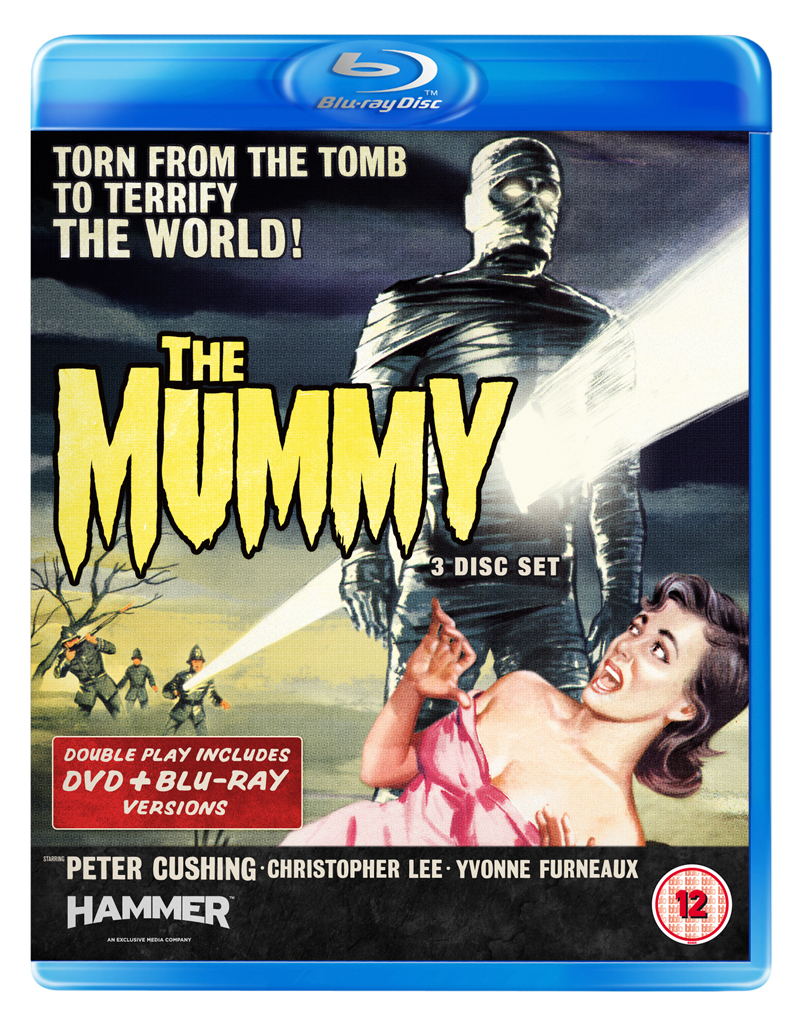
The Mummy Blu-ray Review
 To many the early days of Hammer horror movies it looked simply like they were re-making old Universal horrors, but that is to miss much of the beauty and charm of these films. Hammer had already re-hashed Frankenstein and Dracula as well as having made their own very British brand of science-fiction aliens from another planet films which included two Quatermass films (themselves big screen adaptations of TV sci-fi dramas) and X – the Unknown (1956), the first film which Jimmy Sangster scripted. Now it was the turn of the studio to turn to another mainstay of Universal and that was the mummy. But this time it was not a remake of the Universal namesake from 1932 which had starred Boris Karloff but instead a later sequel, The Mummy’s Hand (1940).
To many the early days of Hammer horror movies it looked simply like they were re-making old Universal horrors, but that is to miss much of the beauty and charm of these films. Hammer had already re-hashed Frankenstein and Dracula as well as having made their own very British brand of science-fiction aliens from another planet films which included two Quatermass films (themselves big screen adaptations of TV sci-fi dramas) and X – the Unknown (1956), the first film which Jimmy Sangster scripted. Now it was the turn of the studio to turn to another mainstay of Universal and that was the mummy. But this time it was not a remake of the Universal namesake from 1932 which had starred Boris Karloff but instead a later sequel, The Mummy’s Hand (1940).
The story begins in Egypt in 1895 with Stephen Banner (Felix Aylmer), an eminent archaeologist who is about to unearth the tomb of Princess Ananka with his son John (Peter Cushing) who is laid up due to a leg injury. When the tomb is opened a scream comes from the tomb with Stephen Banner having suffered an apparent mental collapse and is subsequently committed to a mental asylum back in England. Months later excavations have finished and John Banner can come home to England and help care for his father who is insisting that he was visited by a living mummy in the tomb. At the same time a mysterious Egyptian rents a nearby house in the same village and brings with him a cart load of relics from Egypt which end up in the swamp due to an accident. The mysterious Egyptian, Mehmet Bey (George Pastell) uses the scroll of life to waken the mummy, Kharis (wonderfully played by Christopher Lee) and bring him back to life. Bey instructs Kharis to avenge Ananka and kill those who had desecrated her tomb.
Shot in the now colourful Eastmancolor one would expect from Hammer, the luminous colours come to life in this new dual format triple disc – Pastell’s fez and the putrid greens of the swamp are particularly vibrant. The film is shown in two formats the normal standard 1.66:1 ratio and the never released before original 1.37:1 and worthwhile it is too. Although it is not until the last half of the film that the pace really picks up it is one of the classics with Cushing as ever lending an air of legitimacy to the proceedings as he did with nearly all films he appeared in. One cannot take Chris Lee for granted, however, as he lumbers quite energetically through the film with some fantastic movements; undeniably an actor performing extremely well with just his eyes. Despite the odd shortcoming – the not very realistic Egyptian set at the beginning of the film and in a flashback to Ancient Egypt the films handles its limitations very well and when sat next to the other three mummy films Hammer made it has a lot of style and class to it. From the opening credit sequences with its big Hollywood-like score by Franz Reizenstein, a German émigré who’s rare score for the screen this was giving a hint of what Hammer’s ambitions were.
The extras on the disc are plentiful and add context to the main feature which include an early Hammer foray into the mad doctor film with Stolen Face (1952) a B movie from the studio which had two Hollywood leads in Paul Henreid (who over 15 years previously had played Laszlo in Casablanca with Humphrey Bogart) and Lizabeth Scott (who was also a regular Bogart co-star) making it something of a minor success. The film was also directed by Terence Fisher, who was most certainly at the helm of the majority of Hammer’s best films including The Mummy. There is also the usual Hammer TV documentary this time focussing on Cushing, as well as a short documentary about all the repertory bit character players who regularly appeared in Hammer films which include Michael Ripper and Harold Goodwin. But the real treats are a Making Of documentary and another wonderful 45 minute documentary about Hammer at Bray where all these early films were shot (the exterior and interiors of John Banner’s house were shot at the main house of Bray) until 1965 with the documentary really enforcing how much the crew and company had a very protective family attitude towards each other and the division this created with the main business office in Wardour Street, Soho. It goes into detail with regards the personnel from the producers to the stars to the writers, designers and costume people down to the runners. A very enlightening and wonderful documentary with interviews and commentary from regular Hammer historians, Jonathan Rigby and Marcus Hearn, two film historians who have done much to keep the spirit of the British horror film alive.
This is a wonderful and complete package with some great artwork on the cover illustrating the film’s poster depicting the police pursuing the zombie through the swamp with a torchlight shining through the mummy’s wrappings. Long may Studiocanal keep putting out these great Hammer films with their accompanying documentaries and extras.
Chris Hick
